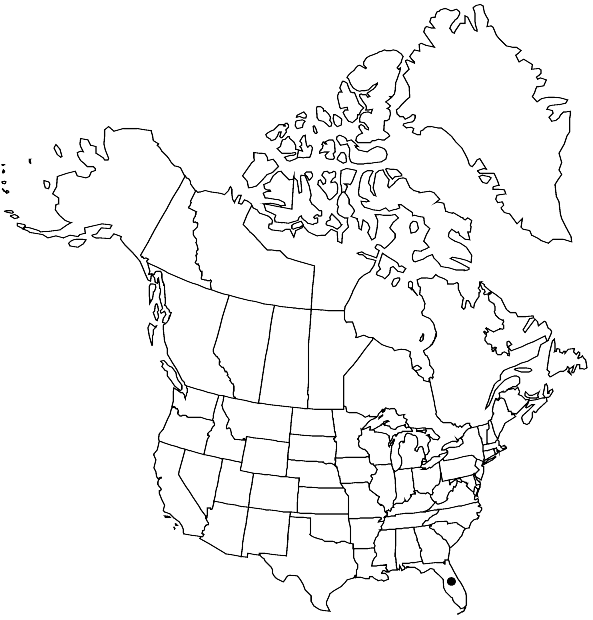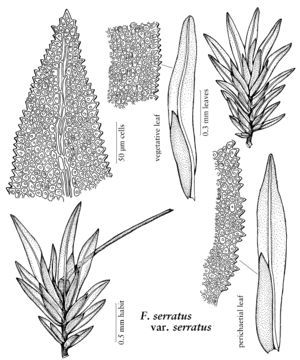Fissidens serratus var. serratus
Plants to 2.8 × 1.5 mm. Stem unbranched and branched; axillary hyaline nodules present; central strand absent. Leaves as many as 6 pairs, lanceolate, acute to obtuse, to 1.5 × 0.2 mm; dorsal lamina narrowed proximally, ending at insertion, not decurrent; vaginant laminae ± 1/2 leaf length, ± equal, minor lamina ending on or near margin, often rounded and free; margin serrate, often coarsely and irregularly so on vaginant laminae, elimbate, or limbate and entire on proximal 1/2 or less of perichaetial leaves, limbidium weak, of 1–2 rows of cells, limbidial cells 1-stratose; costa percurrent to ending as many as 3 cells before apex, bryoides-type; laminal cells 1-stratose, distinct, sharply 1-papillose, firm-walled, irregularly quadrate to hexagonal, 7–11 µm. Sexual condition rhizautoicous; perigonial gemmiform, proximal to perichaetial stems. Sporophytes 1 per perichaetium. Seta to 3.5 mm. Capsule theca exserted, erect, radially symmetric, to 0.5 mm; peristome scariosus-type; operculum 0.5 mm. Calyptra cucullate, smooth, 0.4 mm. Spores 13–20 µm.
Habitat: Decaying logs, living cypress trees
Distribution

Fla., Mexico, West Indies, Central America, South America, Asia, Africa.
Discussion
In North America, Fissidens serratus is restricted to peninsular Florida, extending north to Leon and Jefferson counties. The species is characterized by distinct, 1-papillose laminal cells and sharply serrate leaf margin, often coarsely and irregularly so on the vaginant laminae. Perichaetial leaves can be limbate and entire on proximal parts of vaginant laminae. Filamentous, muticellular gemmae have been observed at the stem apices of African plants. Variety leptochaete (Dusén) Bruggeman-Nannenga & Pursell (tropical America, tropical Africa, New Zealand) differs by having an intralaminal limbidium on vaginant laminae of most or all leaves.
Selected References
None.
